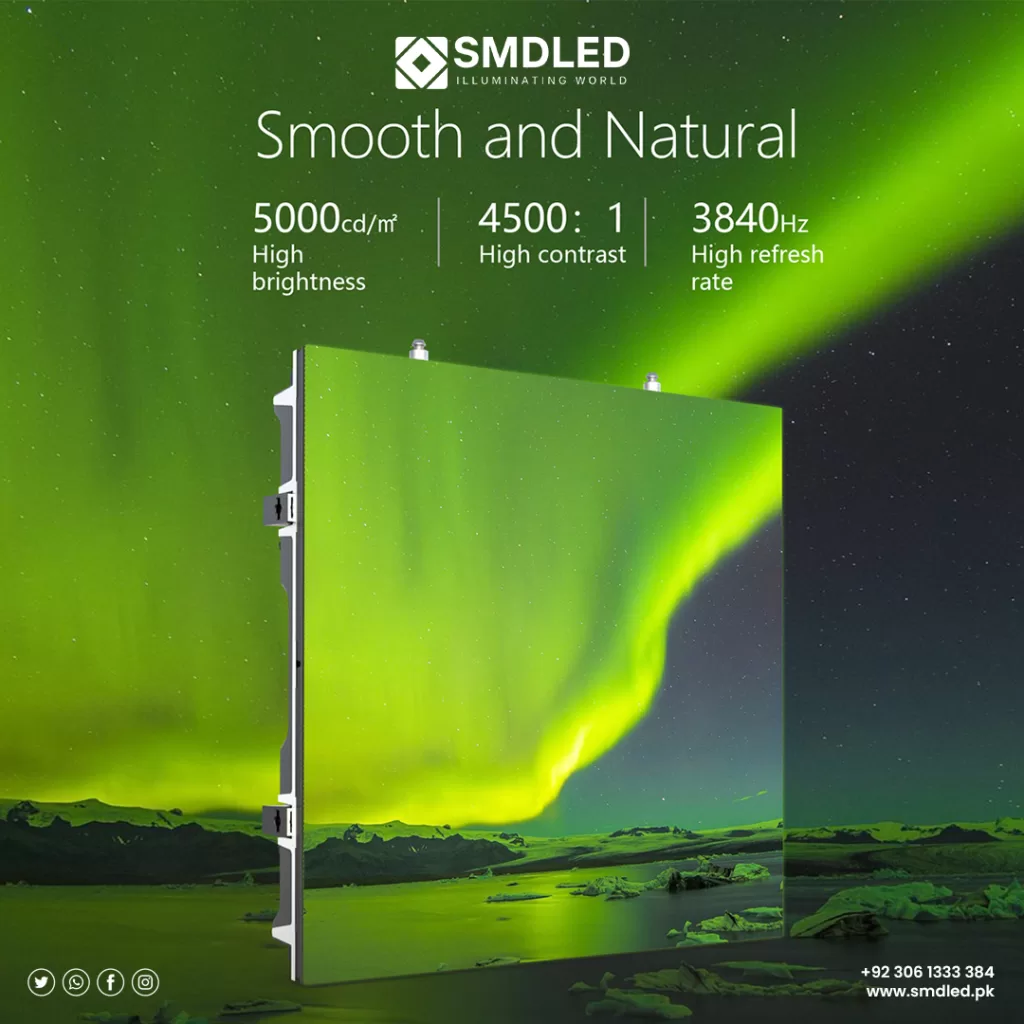The Green Revolution: SMD Screens and Environmental Sustainability
In an era where technological advancements and digital innovation have become an integral part of our lives, the concept of sustainability has emerged as a critical concern. The need to minimize our carbon footprint and adopt environmentally-friendly practices has never been more pressing. Amidst these pressing concerns, a technology known as Surface-mount Device (SMD) screens has emerged as a frontrunner in revolutionizing the way we view electronic displays. This article aims to explore the significant impact of SMD screens on environmental sustainability, shedding light on its remarkable features and its potential to reshape the future of display technology.
Table of Contents
- The Benefits of SMD Screens in Promoting Environmental Sustainability
- Understanding the Environmental Impact of SMD Screens: A Comprehensive Analysis
- Recommendations for Maximizing Energy Efficiency in SMD Screens
- Exploring the Role of SMD Screens in Reducing E-waste and Increasing Longevity
- Q&A
- To Conclude

The Benefits of SMD Screens in Promoting Environmental Sustainability
As the world embraces the need for environmental sustainability, technological innovations are playing a crucial role in reducing our carbon footprint. One such innovation is the use of Surface-Mount Display (SMD) screens, which are proving to be a game-changer in promoting eco-consciousness. SMD screens, unlike their traditional counterparts, offer several benefits that help mitigate environmental impact while still delivering impressive visual experiences.
1. Energy Efficiency
One of the key advantages of SMD screens is their superior energy efficiency. These screens utilize light-emitting diodes (LEDs) that consume significantly less power compared to older display technologies. By adopting SMD screens, businesses and individuals can save on electricity consumption, resulting in reduced greenhouse gas emissions and lower energy costs in the long run.
2. Reduced E-Waste
Another noteworthy benefit of SMD screens is their contribution to reducing electronic waste. Traditional screens often contain mercury and other harmful components that pose serious environmental hazards when disposed of improperly. On the other hand, SMD screens are made with fewer toxic materials, making them easier and safer to recycle or dispose of. This not only limits the amount of hazardous waste going into landfills, but it also promotes a more circular economy that strives to eliminate waste and maximize resource utilization.
Embracing SMD screens is a sustainable choice that aligns with the global efforts towards environmental preservation. By being energy-efficient and reducing e-waste, these screens are helping pave the way for a greener future. As technology continues to advance, it is imperative that we invest in eco-friendly alternatives like SMD screens to ensure a harmonious coexistence between technology and the environment.

Understanding the Environmental Impact of SMD Screens: A Comprehensive Analysis
SMD screens have become an integral part of our modern world, revolutionizing the way we communicate, entertain, and work. However, the widespread use of these screens also comes with a significant environmental impact that cannot be ignored. In this comprehensive analysis, we delve deep into understanding the environmental ramifications of SMD screens and explore how their design and production can be aligned with principles of sustainability.
One of the key environmental concerns surrounding SMD screens is their energy consumption. These screens are known for their high brightness and vibrant colors, thanks to the use of light-emitting diodes (LEDs). While LEDs are energy-efficient compared to other types of lighting, the sheer number of SMD screens in use today means that the overall energy demand is substantial. Additionally, the production process of SMD screens involves the use of rare earth elements and potentially hazardous materials, requiring careful handling and disposal to minimize the impact on ecosystems and human health.
- Reducing energy consumption: Manufacturers can implement energy-saving technologies such as automatic brightness adjustment and power management features to minimize the energy consumption of SMD screens.
- Eco-friendly materials: Research and development efforts should focus on finding alternatives to rare earth elements and hazardous materials, promoting the use of more sustainable components in SMD screen production.
- Lifecycle management: Emphasizing the importance of proper recycling and disposal processes for old or damaged SMD screens to prevent harmful substances from entering the environment and to support a circular economy.
| Environmental Impact: | Energy consumption, carbon emissions, waste generation |
| Sustainable Solutions: | Energy-saving technologies, eco-friendly materials, lifecycle management |
| Benefits of Environmental Sustainability: | Reduced carbon footprint, conservation of resources, protection of ecosystems |
Addressing the environmental impact of SMD screens is not only essential for the well-being of our planet but also presents an opportunity for innovation and growth. By adopting sustainable practices, manufacturers can minimize their carbon footprint, conserve resources, and protect ecosystems. As consumers, we can also play a crucial role in promoting environmental sustainability by making informed choices and supporting companies that prioritize eco-friendly practices.
As the world continues to rely heavily on SMD screens for various purposes, it is imperative that we prioritize their environmental impact and strive towards a greener future. By understanding the complexities of this issue and working collaboratively, we can ensure that the benefits of SMD screens are truly sustainable and contribute to a more environmentally conscious society.

Recommendations for Maximizing Energy Efficiency in SMD Screens
One of the key challenges in today’s digital age is striking a balance between technological advancements and environmental sustainability. As the demand for energy-efficient devices continues to grow, it is crucial to implement effective strategies for maximizing energy efficiency in SMD (Surface-Mount Device) screens. By adopting these recommendations, we can minimize the environmental impact of SMD screens while still enjoying their cutting-edge capabilities.
To begin with, optimizing the brightness settings of SMD screens can greatly contribute to energy efficiency. Adjusting the screen brightness to a level that is comfortable for users while still being easy on the eyes can significantly reduce power consumption. Additionally, enabling automatic brightness adjustment based on ambient light conditions can further optimize energy usage. This can be easily achieved by utilizing the built-in brightness sensors in SMD screens or by installing external light sensors if necessary.
Another essential aspect is the choice of display mode. Utilizing dark or black themes and backgrounds for applications and websites can substantially reduce energy consumption, as dark pixels require significantly less power than their brighter counterparts. Encourage users to switch to dark modes whenever possible and provide them with resources on how to enable this feature on their devices. Furthermore, implementing screen timeout settings and encouraging users to adjust them to shorter durations can contribute to minimizing unnecessary energy consumption when screens are not in active use.
In addition to these recommendations, it’s essential to consider the overall power efficiency of the SMD screens themselves. Selecting screens that comply with energy efficiency standards, such as ENERGY STAR, can serve as a starting point. Moreover, promoting the use of screens with lower power consumption, such as OLED (Organic Light-Emitting Diode) displays, can have a significant impact on reducing energy usage.
Implementing these recommendations can pave the way for a greener revolution in the use of SMD screens. By maximizing energy efficiency, we can ensure that the technological advancements of today do not come at the cost of our planet’s well-being. Let us embrace these strategies and work towards a more sustainable future for us and generations to come.

Exploring the Role of SMD Screens in Reducing E-waste and Increasing Longevity
SMD screens, also known as Surface-Mount Device screens, have emerged as a game-changer in the realm of technology, playing a crucial role in reducing e-waste and increasing the longevity of electronic devices. These screens, which are widely used in various electronic devices such as smartphones, tablets, and televisions, offer several innovative features that contribute to environmental sustainability.
One of the key benefits of SMD screens is their compact design and lightweight construction, utilizing minimal materials during production. This not only reduces manufacturing costs but also decreases the overall amount of electronic waste generated. Additionally, SMD screens consume less power and emit lower levels of heat compared to traditional screens, resulting in reduced energy consumption and longer battery life for portable devices. This not only helps in reducing greenhouse gas emissions but also promotes a more sustainable approach to using electronic devices.
Furthermore, SMD screens come equipped with advanced technologies such as OLED (Organic Light Emitting Diode) and AMOLED (Active Matrix Organic Light Emitting Diode) displays. These technologies offer exceptional image quality, vibrant colors, and high contrast ratios, resulting in an enhanced user experience. By providing visually appealing displays, SMD screens encourage users to hold onto their devices for longer periods, reducing the frequency of device upgrades and ultimately minimizing electronic waste.
In summary, SMD screens have emerged as a crucial factor in the pursuit of environmental sustainability. With their compact design, energy-efficient operation, and advanced display technologies, these screens play a significant role in reducing e-waste and extending the lifespan of electronic devices. Embracing SMD screens not only benefits the environment but also contributes to cost savings and improved user experiences. As we continue to strive for a greener future, the integration of SMD screens in our electronic devices is a step towards a more sustainable and eco-friendly world.
Q&A
Q: What is the Green Revolution and how does it relate to SMD screens?
A: The Green Revolution refers to the global movement towards environmental sustainability. SMD (Surface Mount Device) screens play a crucial role in this revolution as they are designed to minimize energy consumption and reduce the environmental impact of display technologies.
Q: How do SMD screens contribute to environmental sustainability?
A: SMD screens are highly energy-efficient, consuming less power compared to traditional display technologies. Their design allows them to emit less heat and use fewer resources in manufacturing. This efficiency leads to reduced carbon emissions and lower energy costs, promoting a more environmentally sustainable approach to display technology.
Q: Are SMD screens recyclable?
A: Yes, SMD screens are highly recyclable. Their compact design and efficient use of materials make them easier to dismantle and recycle compared to other display technologies. Recycling SMD screens helps reduce electronic waste and conserves valuable resources.
Q: Are there any regulations in place to promote the use of SMD screens?
A: Some countries and regions have introduced regulations or incentives to encourage the adoption of energy-efficient technologies, including SMD screens. For instance, the European Union has implemented energy labeling requirements for electronic devices to promote energy-conscious choices for consumers and encourage manufacturers to produce more eco-friendly products.
Q: How does the use of SMD screens contribute to energy conservation?
A: SMD screens utilize advanced backlighting technologies, such as LED (Light Emitting Diode), which consume less energy compared to older display technologies. This optimized energy consumption not only reduces electricity bills for users but also helps conserve energy resources by lowering overall power demand.
Q: Are there any drawbacks to the use of SMD screens?
A: While SMD screens offer numerous benefits in terms of energy efficiency and environmental sustainability, they may have higher manufacturing costs compared to traditional display technologies. However, these costs usually balance out over the lifespan of the screen due to lower energy consumption and longer durability.
Q: Can SMD screens be used in various applications?
A: Absolutely. SMD screens are versatile and can be used in a wide range of applications, from consumer electronics like smartphones and televisions to large-scale digital signage and commercial displays. Their versatility makes them an ideal choice for both personal and professional use, contributing to sustainability across various industries.
Q: How can consumers support the Green Revolution when it comes to display technologies?
A: Consumers can support the Green Revolution by actively choosing products that utilize SMD screens and other energy-efficient technologies. By selecting devices with energy-efficient labels and certifications, consumers can contribute to reducing carbon emissions and promoting environmental sustainability in the electronics industry.
Q: What is the future of SMD screens and environmental sustainability?
A: The future of SMD screens looks promising in terms of environmental sustainability. Fueled by continuous advancements in technology and rising consumer demand for eco-friendly solutions, SMD screens are likely to become the standard in display technology. These screens will continue to play a vital role in the Green Revolution, helping us reduce our ecological footprint and create a more sustainable future.
To Conclude
In light of the global urgency to steer towards a more sustainable future, the adoption of SMD screens as part of the Green Revolution presents a commendable step forward. As we have explored the myriad environmental benefits of these screens, it becomes evident that the technology offers a monumental opportunity to mitigate the environmental impact caused by conventional display systems. The reduced energy consumption, diminished use of hazardous components, and enhanced recyclability of SMD screens all contribute to a more sustainable, eco-friendly paradigm in the electronics industry.
However, it is crucial to acknowledge that while SMD screens offer immense promise in terms of environmental sustainability, achieving widespread adoption and minimizing the associated ecological footprint requires collective responsibility. It necessitates collaboration between governments, manufacturers, consumers, and the broader electronics industry to create an ecosystem that prioritizes the production and utilization of environmentally friendly display technologies.
If we invest in research and development, incentivize eco-design strategies, implement effective waste management systems, and promote consumer awareness, we can ensure that the Green Revolution fueled by SMD screens is not just a passing trend but a transformative force for lasting positive change. As consumers, we have the power to drive demand for sustainable electronics and support companies that actively pursue green alternatives. By making informed choices and demanding transparency from manufacturers, we can play an active role in shaping an environmentally responsible electronics industry.
The SMD screen’s potential to contribute to environmental sustainability cannot be understated. By embracing this technology, we have an unprecedented opportunity to align our technological advancements with our ecological aspirations. The Green Revolution beckons, and through the adoption of SMD screens, the path towards a greener, more sustainable future becomes clearer than ever before. Let us seize this moment to cultivate a world where cutting-edge technology and environmental responsibility go hand in hand, creating a brighter and more sustainable tomorrow for generations to come.
Looking for premium SMD screens and professional display solutions? SMDLED.PK is your trusted partner for state-of-the-art SMD technology. Explore our top-quality products like the stunning Leyard HDR 4K SMD Video Wall for crystal-clear visuals, the versatile MSA Plus SMD LED Screen Module, the sleek MSA Ultra Thin SMD LED Screen Module for modern setups, the durable MSG Outdoor SMD LED Screen Module, and the efficient MSG Indoor SMD LED Screen Module perfect for indoor environments.
We also offer exceptional Outdoor SMD Screens, Indoor SMD Screens, Flexible SMD Screens for creative designs, Cabinet SMD Screens for secure setups, Signpole SMD Screens for advertising, and stunning SMD Video Walls for large-scale visual impact. With SMDLED.PK, experience reliability, superior technology, and tailored solutions for all your display needs. Visit us today and transform your spaces with unparalleled visual excellence!
Contact Us For Free Consultation at 0306-1333384
Powered By BIACommunication

